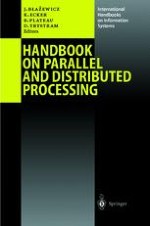2000 | OriginalPaper | Buchkapitel
Parallel and Distributed Scientific Computing
A Numerical Linear Algebra Problem Solving Environment Designer’s Perspective
verfasst von : A. Petitet, H. Casanova, J. Dongarra, Y. Robert, R. C. Whaley
Erschienen in: Handbook on Parallel and Distributed Processing
Verlag: Springer Berlin Heidelberg
Enthalten in: Professional Book Archive
Aktivieren Sie unsere intelligente Suche, um passende Fachinhalte oder Patente zu finden.
Wählen Sie Textabschnitte aus um mit Künstlicher Intelligenz passenden Patente zu finden. powered by
Markieren Sie Textabschnitte, um KI-gestützt weitere passende Inhalte zu finden. powered by
This chapter discusses the design of modern numerical linear algebra problem solving environments. Particular emphasis is placed on three essential components out of which such environments are constructed, namely well-designed numerical software libraries, software tools that generate optimized versions of a collection of numerical kernels for various processor architectures, and software systems that transform disparate, loosely-connected computers and software libraries into a unified, easy-to-access computational service.A brief description of the “pioneers”, namely the EISPACK and LINPACK software libraries as well as their successor, the Linear Algebra PACKage (LAPACK), illustrates the essential importance of block-partitioned algorithms for shared-memory, vector, and parallel processors. Indeed, these algorithms reduce the frequency of data movement between different levels of hierarchical memory. A key idea in this approach is the use of the Basic Linear Algebra Subprograms (BLAS) as computational building blocks. An outline of the ScaLAPACK software library, which is a distributed-memory version of LAPACK, highlights the equal importance of the above design principles to the development of scalable algorithms for MIMD distributed-memory concurrent computers. The impact of the architecture of high performance computers on the design of such libraries is stressed.Producing hand-optimized implementations of even a reduced set of well designed software components such as the BLAS for a wide range of architectures is an expensive and tedious proposition. For any given architecture, customizing a numerical kernel’s source code to optimize performance requires a comprehensive understanding of the exploitable hardware resources of that architecture. Since this time-consuming customization process must be repeated whenever a slightly different target architecture is available, the relentless pace of hardware innovation makes the tuning of numerical libraries a constant burden. This chapter presents an innovative approach to automating the process of producing such optimized kernels for various processor architectures.Finally, many scientists and researchers increasingly tend nowadays to use simultaneously a variety of distributed computing resources such as massively parallel processors, networks and clusters of workstations and “piles” of PCs. This chapter describes the NetSolve software system that has been specifically designed and conceived to efficiently use such a diverse and lively computational environment and to tackle the problems posed by such a complex and innovative approach to scientific problem solving. NetSolve provides the user with a pool of computational resources. These resources are computational servers that provide run-time access to arbitrary optimized numerical software libraries. This unified, easy-to-access computational service can make enormous amounts of computing power transparently available to users on ordinary platforms.
